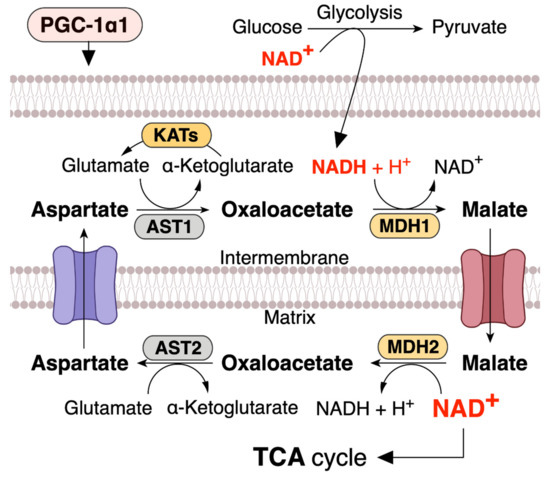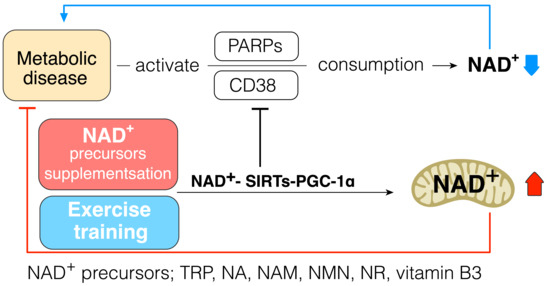6. NAD+–SIRT1–PGC-1α Pathway in Diabetes
Mitochondrial function is involved in whole-body and cellular glucose homeostasis, and mitochondrial functions are decreased in states of insulin resistance and diabetes
[2]. It is well established that an increase in mitochondrial function by exercise training in various metabolic tissue, including skeletal muscle and adipose tissue, of the insulin resistance or diabetes subjects improves glucose homeostasis
[67][68]. Thus, mitochondrial function is important for glucose homeostasis.
SIRTs directly interact with PGC-1α and deacetylate at specific lysine residues in an NAD
+-dependent manner, activating PGC-1α
[69]. Thus, NAD
+–SIRTs–PGC-1α pathway plays a critical role in glucose homeostasis in diabetes and lifespan
[69]. As we discussed above, since mitochondria function as a warehouse of NAD
+, and PGC-1α regulates mitochondrial biogenesis in metabolic tissue, NAD
+, SIRT1, and PGC-1α play an important role in their function of regulating glucose homeostasis in each other. In metabolic tissue, including skeletal muscle, liver, and adipose tissue, of T2DM state, PGC-1α protein and NAD
+ levels are downregulated, as is SIRT1 activity
[33][70][71][72]. These shifts are clearly linked to the mitochondrial functions, numbers, and size
[33][70][71][72].
As the strategy to increase cellular NAD
+ levels, the biosynthesis of NAD
+ should be increased, and its consumption should be prevented. Daily intake of NAD
+ precursor is one of the strategies to increase NAD
+ synthesis and improve metabolic function in diabetes. Indeed, a previous study has shown that tryptophan supplementation increases lifespan through NAD
+ de novo synthesis
[73], and acipimox, an NAD
+ precursor, can directly improve skeletal muscle mitochondrial function in T2DM patients
[74]. Mice receiving NR were protected against high fat diet induced weight gain and had higher insulin sensitivity with increased mitochondrial content in skeletal muscle and brown adipose tissue
[75]. Niacin supplementation can improve lipid profiles in T2DM patients
[76]. These data suggest that supplementation of NAD
+ precursor can be one of the strategies to improve insulin resistance and treat T2DM ().
Figure 3. NAD+–SIRTs–PGC-1α pathway increases NAD+ pool and inhibits NAD+ consumption. NAD+ precursors: tryptophan (Trp), nicotinic acid (NA), nicotinamide (NAM), NAM mononucleotide (NMN), nicotinamide riboside (NR), vitamin B3; metabolic diseases: insulin resistance, type 2 diabetes.
It is widely accepted that exercise can provide many health-beneficial effects for T2DM patients; in this context, exercise could increase the cellular NAD
+ pool in an indirect way via endogenous enzyme alteration to activate its synthesis or protect the NAD
+ pool against overconsumption. Indeed, a previous study has revealed that trained muscle has a higher level of NAD
+ pool, and aerobic and resistance exercise training improves the capacity of NAD
+ salvage pathway in aged human skeletal muscle
[20]. AMPK is activated by exercise
[77], and it is well evidenced that AMPK regulates the gene expression related to energy metabolism in mouse skeletal muscle via coordination with SIRT1 and enhances its activity by increasing cellular NAD
+ pool
[78]. Exercise increases NAMPT in human skeletal muscle
[79], and NAMPT overexpression in mice skeletal muscle increases muscle NAD
+ levels and protects against body weight gain in high-fat-fed mice, as well as increasing mitochondrial gene expression and endurance capacity
[80]. Exercise-training-induced increase in mitochondrial biogenesis in tissue also protects against overconsumption of NAD
+ because the mitochondrial capacity for NAD
+ conservation is higher than that of the cytoplasm
[47][48][51][57][58][59] ().



